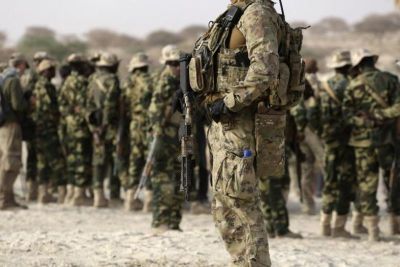US military forces cannot fight on 2 fronts

The current war in Ukraine and Russia’s threatening actions toward NATO countries coupled with a rising China in Asia highlights a strategic pickle for the United States — the need to be able to deter or potentially fight two major adversaries in two very different regions of the world at the same time with the military it has on hand.
While the U.S. is unlikely to face two significant competitors at the same time, the possibility is not zero. The current situation in Ukraine, with Russian President Vladimir Putin launching missiles landing close to Poland, and Chinese President Xi Jinping’s ideological commitments to bring Taiwan into China, provides an excellent opportunity for an opportunist nation to attempt a hostile act while the rest of the world is distracted.
The U.S. is a global power with interests and responsibilities throughout the world. It must be capable of protecting Americans abroad, allies and the freedom to use international sea, air, space and cyberspace.
This is no easy task — and the U.S. military today is not positioned to take it on.
It is too small and too old to fight on numerous fronts. Force drawdowns since the end of the Cold War and 20 years of fighting in the Middle East have left the U.S. military a shell of its former self.
This should worry everyone — especially because China and Russia spend a significant portion of their economic output on their defense budgets, with the purpose of challenging American military superiority.
The Chinese government is rapidly expanding its military forces. Perhaps the most visible example of this is its ship-building program. At the end of 2020, the size of China’s navy was approximately 360. Compare that to a U.S. Navy fleet of 297 ships.
China’s military forces must be modernized by 2035, according to Xi. By 2049, he claims, they should be a “world-class” military power capable of “fighting and winning wars.”
China’s breakthroughs in its hard-power capabilities are likely to lead to a significant shift in the global balance of military power.
As for Russia, its military capabilities are on display on the world stage.
The U.S. military has an overall advantage over the Russian military, but Russia has select advantages over the U.S. when it comes to certain capabilities. For example, the U.S. Army has approximately 6,000 tanks while Russia has around 12,000. Russian tactical nuclear capabilities outnumber the U.S. by 10-to-1.
One cannot forget about the threat that Iran and North Korea also pose to U.S. national security, with their missile arsenals and nuclear programs. It is vital for the U.S. to be able to project strength globally to provide reassurance for its allies and deter its adversaries.
While the quality of the U.S. military force is currently unrivaled, its size is at a historic low, and this limits its ability to respond to the multiple threats the country faces globally. It simply does not have enough forces.
This is a concern, particularly when the U.S. needs to surge to a conflict without jeopardizing the posture of U.S. forces in another important region.
For example, if the United States were to engage Russia in a direct confrontation, it will be forced to deploy military equipment and personnel from all over the world to the Eastern European front. By doing so, the U.S. would be forced to draw forces from other regions of the world, such as the West Pacific, where our presence is critical in deterring China.
The Heritage Foundation’s annual assessment of U.S. military power, the 2022 Index of U.S. Military Strength, assesses that the U.S. military is only moderately capable of securing its vital national security interests, and would struggle greatly if called upon to deal with more than one competitor at a time.
Low levels of capacity are particularly concerning because numbers really matter in war.
The index estimates that a joint force capable of dealing with multiple fronts simultaneously would need to consist of:
- The Army having 50 brigade combat teams, compared to its current number of 31.
- The Navy having at least 400 ships, compared to the 297 vessels it currently has.
Since President Ronald Reagan’s military buildup to deter the Soviets in what would be the final years of the Cold War, the overall trend in numbers has clearly been consistently toward a smaller force. Besides force size, some of the military’s equipment is extremely outdated, and many of its platforms entered service more than 30 years ago.
The services, like the Army and Navy, are aging faster than they are modernizing. As a result, it will be easier for major competitors to reach technological parity with the U.S. military.
To recap, the U.S. requires a force capable of managing two conflicts because it would provide enough forces to: 1. deter an opportunistic adversary from starting a conflict while the U.S. is engaged and 2. provide the U.S. with a sufficient number of forces to handle battle losses without requiring America to denude the rest of the world to focus on one conflict.
The good news is that there appears to be bipartisan acknowledgment of the need to project power on two fronts.
“It’s difficult. It’s expensive. But it is also essential, and I believe that we’re entering a period where that is what will be demanded of the United States and this generation of Americans,” said Kurt Campbell, the White House Indo-Pacific policy coordinator, about the U.S. remaining engaged in the Indo-Pacific in the midst of the crisis in Ukraine.
But it remains to be seen whether Congress and the Biden administration address the need to field a military force sufficiently sized to address global threats and U.S. national interests. The defense budget must be sufficient to modernize and expand the force. It will take time for the military to reach the level of strength required to deter and potentially fight on multiple fronts.
The problem will not be fixed overnight. That’s why it’s important for Congress to act quickly to adequately resource the U.S. military.
Originally published at The Daily Signal.
James Di Pane is a policy analyst focusing on defense policy in the Davis Institute for National Security and Foreign Policy at The Heritage Foundation.
Octavian Miller is a member of the Young Leaders Program at The Heritage Foundation.





















